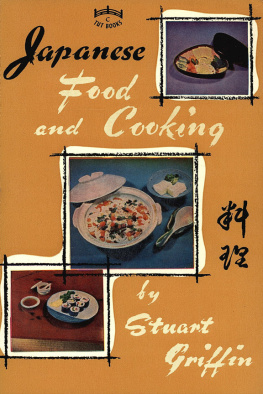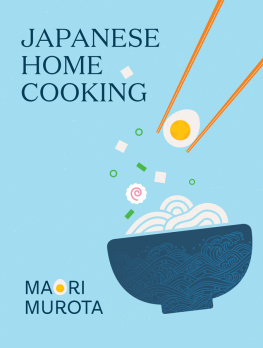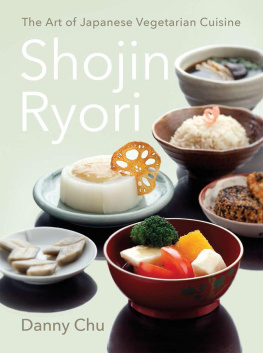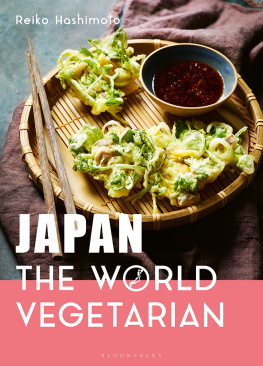Table of Contents
1999 Miyoko Nishimoto Schinner
Cover photograph: Don McGarrah Photography Inc.
Cover design: Jeanne Kahan
Cover food stylist: Miyoko Nishimoto Schinner
Interior design: Warren Jefferson
Pictured on font cover, clockwise from upper left: Vegetarian Eel Over Rice (Unaju or Unagi Donburi), page 142; Fried Tofu Dumplings (Hirosu), page 81; Daikon Salad with Lime-Ume Dressing (Daikon Salada), page 164
Pictured on back cover, clockwise from lower left: Bottom trayFried Tofu Dumplings (Hirosu), page 81; Stewed (Ni-Mono) konnyaku, carrots, lotus root, burdock root, page 128; Upper Box (clockwise form left)Freeze-Dried Tofu (Koya dofu), page 82; Stewed (Ni-Mono) taro root and bamboo shoots, page 128; Bowl on rightNew Years Stew with O-Mochi (Ozoni), page 69
Published in the United States of America by:
Book Publishing Co.
P.O. Box 99
Summertown, TN 38483
888-260-8458
All rights reserved.
02 01 00 99
6 5 4 3 2 1
ISBN 1-57067-072-2
Schinner, Miyoko Nishimoto,
Japanese cooking Contemporary & traditional: simple, delicious, and vegan / Miyoko Nishimoto Schinner.
P. Cm.
Includes index.
ISBN 1-57067-072-2 (alk. paper)
1. Vegetarian cookery. 2. Cookery, Japanese. I. Title.
II. Title. Contemporary and traditional Japanese cooking.
TX837.S29 1999
641.56360952dc21
98-54936
CIP
Introduction
Historical and New Flavors of Japan
I shi-yaki-imo! Ishi-yaki-imo! The singsong cry of the sweet potato peddler would echo again and again, resounding into every home on the street. Children and mothers, lured by the sweet smell, would run out to buy the simple treat from the hand-pulled cart, heavily laden with sweet potatoes buried in hot rocks. I remember, too, as a young child being lured by the beauty of the cry, warming my hands over the rocks in the cart and biting into the smoky sweetness of roasted yams.
T oday, the ubiquitous sweet potato peddler drives a truck and has a recording of his famous cry playing repeatedly over a megaphone. Still, his truck is filled with the same rocks and potatoes; still, the wafting smell is as sweet and smoky. Thirty years later, the satisfaction felt from biting into the steaming hot potato is as uncomplicated and deep, a joy that can only be derived from the simplest things.
Japanese cuisine, as may be said of many things Japanese, is grounded in simplicity and purity. Whereas the cuisine of other cultures may dazzle and delight by the complexity of ingredients and techniques, Japanese cuisine reduces the number of components in a dish to a minimalist act that allows the character of each player to resonate with clarity. Flavors are pure and true, unfettered by the many spices and seasonings encountered in dishes of other countries. A classic example would be Horenso-no-Hitashi, where blanched spinach is served with just a sprinkling of soy sauce. The sweetness of the spinach is hardly ever so pronounced as when served in such stark simplicity. Another is Furo Fuki Daikon (page 130), a warming dish of thick daikon radish rounds simmered until practically melting, topped with a sweet miso sauce. The delicate flavor of fresh tofu may be accentuated only by a zesty ponzu (light, salty, citrus dipping sauce) in Yu-Dofu (Tofu in Hot Water). Or with the roasted sweet potatoes the food can stand on its own. How absolutely zen that so much can result from so little!
The ultimate dining experiences in Japan is kaiseki cuisine. They take place at country inns, temples, and hundreds-of-years-old restaurants where a diner sits on tatami mats in a starkly decorated room. The shoji screen doors are flung wide open, and the room spills out into a Japanese garden of elegantly situated rocks, ponds filled with colorful carp, small shrubs, perhaps a crimson maple tree or twoand tranquility. The diner finds spread before him a vast array of comestibles, each displayed with grace in a variety of individual ceramic and porcelain dishes. The utmost care is taken to adorn each dish, whether it be the accent of a tiny leaf resting on one, or the beautiful composition of a few vegetables in another. The meal thus reflects the garden, consisting of numerous components, each pure and simple, the whole harmonizing in a pastoral symphony. I recall the first time I stayed at a ryokan (high-class Japanese inn) and was amazed at the splendid displayperhaps twelve to fifteen dishes!served in the privacy of our own room. Or the leisurely afternoon spent at a temple for nuns in Tottori Prefecture, where we dined for several hours on course after course (each being very small, of course) of truly vegan shojin-ryori (Buddhist vegetarian cooking).
Naturally, most of Japan does not dine on a daily basis on such elaborate kaiseki cuisine. Although the average Japanese meal served at home would not consist of fifteen dishes, many housewives still prepare five or six. In addition to rice, a typical meal would include soup, either miso or clear, o- shinko (pickles), a protein item such as broiled fish or chilled tofu, a couple of vegetable dishes, perhaps one blanched and the other stewed, and a small and soothing salad in rice vinegar.
From Kyushu in the south to Hokkaido in the far north, you will find the same basic dishes tempura, soba, and ni-mono (stewed dishes)in addition to regional specialties. They will differ primarily in the degree of seasoning used. In the warm south, people prefer their food to be usu-aji (lightly seasoned) with only a splash of soy sauce or a pinch of sea salt. Folks from Hokkaido, or even Tokyo, sometimes find this bland, although natives will attest that it is simply more subtle. In the cold north, koi aji (deeper flavor) is favored, and the dashi (stock) used is darker, saltier, and richer; folks from Osaka often find it too salty. My mother, the Edokko in our family (a person born and raised in the original parts of Tokyo, once called Edo), always prefers her food seasoned with more soy sauce, miso, and salt than I do. (Interestingly, the further north one goes in Japan, the more cases of hypertension one encounters.) In some areas, they may even use a heavy hand in adding sugar. I found that in Tottori Prefecture, a region to the south, the soup stock for udon noodles verged on being strangely sweet. Thus, the amount of soy sauce, miso, sea salt, and sweetener can be varied according to personal taste, and recipes provided in this book often indicate a range.
The Japanese archipelago, once isolated from the world except for the infamous Black Ships from the Netherlands, has eagerly borrowed and absorbed as much from the rest of the world as possible. An exciting culinary evolution has taken place, especially in the past twenty years or so, particularly with the influx of French and Mediterranean cuisine. The influence of the West and other cultures has rendered a new cuisine celebrated by many creative young chefs in Tokyo and other large cities that marry components of two cultures while maintaining traditional Japanese simplicity. This is what I call Nouveau Japonaise (Nouvelle Japanese Cuisine). In addition, the past several decades have also fostered the development of a new home-style cooking, which also often marries the flavors of two cultures. These earthy, albeit sometimes not too healthful, dishes seem to be a favorite of children. They come with names such as Curry Rice, Korrokeh (Potato Croquettes), and White Stew (a bechamel sauce-based stew with vegetables and, usually, meat). Although neither style of cuisine can boast a tradition as long as Furo Fuki Daikon (Stewed Daikon with Sweet Miso, page 130), they have become utterly incorporated into the modern Japanese diet, forever changing the face of the centuries-old shoyu-flavored cuisine. In this book, I have devoted a chapter to each one of these new traditions, vegan-style.

![Miyoko Nishimoto Schinner Japanese Cooking: Contemporary & Traditional [Simple, Delicious, and Vegan]](/uploads/posts/book/41405/thumbs/miyoko-nishimoto-schinner-japanese-cooking.jpg)








